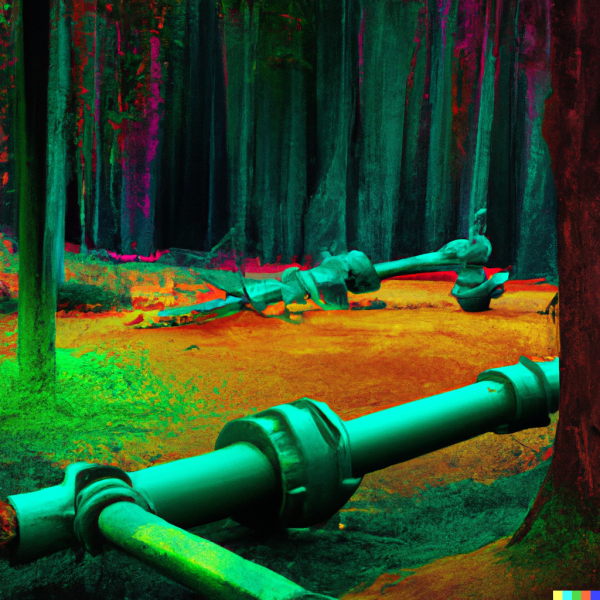Mary Stevens12 Jun 2023
There is an extraordinary scene in the introduction to artist and technologist James Bridle’s recent book, Ways of Being: Animals, Plants Machines: The Search for a Planetary Intelligence (2022). We first meet him in the mountains and forests of northern Greece, tracking the signs of the fossil fuel industry’s plans for this remote and rugged landscape.
“Walking through the woods surrounding the lake, I stumble across thin wooden stakes pushed into the ground and strips of plastic tape tied to branches and saplings. […] Over the next few days I follow these [plastic] lines across fields and vineyards […]. They stretch for hundreds, perhaps thousands of kilometres, like a system of coordinates imposed by a remote, alien intelligence. […] These markings are what I have come to Epirus to see […] Smashed through the forest, gouged into the soil, exploded in the grey light of dawn, these marks, I will discover, are the tooth- and claw-marks of Artificial Intelligence, at the exact point where it meets the earth.” (p.3)
In what sense are these stakes and this tape the footprint of AI? The argument that Bridle makes, compellingly, is that the extraction of fossil fuels from this region has only been made possible by advanced computation and predictive AI. As existing reserves have begun to dry up companies have been looking for ‘unconventional’ sources and it is the power of AI to process huge volumes of data about speculative sites, and hone this into recommendations, that has made these reserves viable.
AI in the decade of technological advance and environmental urgency.
Often, when we think about AI, or about digital technology more generally, we think about it in abstracted form. We think about the communications and behaviours it enables, more than about the physical infrastructure on which it depends. Bridle’s narrative is so compelling because it wrestles the tech giants back down to earth, re-tethering their actions to the very location from which so much western European mythology has emerged.
It also stages a physical clash between two great imperatives of our age: the urgent need, this decade, to bring greenhouse gas emissions under control and recalibrate our collective relationship with the living world and in parallel, to bend the arc of exponential digital technologies away from destruction and towards the healing of our home and ourselves. This is a moment of both breath-taking technological advance and overwhelming environmental urgency.
Far-reaching consequences.
We are only just starting to grapple with the implications of the sudden explosion of a new class of AI technologies into the public-domain. One thing we can be sure about is that they will have far-reaching consequences for every part of our mission at Friends of the Earth, from how we support communities on the frontline of the transition, nationally and globally, to how we communicate with our supporters and tell stories about the change we need. The potential for AI to derail progress on climate action through the production and dissemination of targeted, personalised disinformation is also huge.
We've been here before.
Fortunately, this is not a new topic for us. Back in 2018 we used a design sprint to explore how we could harness the benefits of AI and the automation revolution to deliver breakthrough benefits for all. This led to a number of outcomes, from an exploratory project with Microsoft based on our bee count data, to an ongoing partnership with the Centre for Doctoral Training (CDT) in the Application of Artificial Intelligence to the study of Environmental Risks at Cambridge University(AI4ER).
We spoke on a NESTA panel exploring how AI can help communities respond to the climate crisis (you can watch the recording here). However, many of our ideas for experiments stumbled when it came to data: there was lots that AI could do – in theory – from nudging us towards sustainable behaviours, to increasing the campaigning effectiveness of our groups, but neither the tools nor the data were readily available back then.
A watershed moment - what might become more possible?
Now there is an urgent need - and an opportunity -for us to revisit the topic. It is easy to adopt a determinist position and assume that there is little we can do to shape these emerging technologies in line with our values and vision. But as the AINow Institute explains in its recent 2023 Landscape Report:
It’s time for regulators, and the public, to ensure that there is nothing about artificial intelligence (and the industry that powers it) that we need to accept as given. This watershed moment must also swiftly give way to action: to galvanize the considerable energy that has already accumulated over several years towards developing meaningful checks on the trajectory of AI technologies. […] there is nothing about artificial intelligence that is inevitable.
We would add civil society to that list of actors. Our task now is to identify the leverage points – those places in the system where a modest engagement on our part has potential to be taken up and amplified. Over the next few weeks we will be running a design lab with a view to identifying those points, and designing the experiments that will help us understand the potential to change direction.
This is a complex and shifting problem, so we will be using systems tools designed to highlight and unlock opportunities (building on a process developed by Acumen).
Returning to the scene in northern Greece, James Bridle concludes, ‘something seems to be deeply amiss in what we imagine our tools are for.’ This work is also, deeply, the work of the imagination. But what if we re-imagined our tools in the service of healing our communities and our living home? What might become more possible then?
Join us on July 20.
We will be hosting an online showcase on July 20 to present what has emerged from the lab.
If you would be interested in attending please contact us at [email protected]. We’ll also be looking for people happy to provide feedback on our emerging thinking. And finally we would also love to hear from you if you have ideas to share, or examples from other organisations or movements addressing the same challenge.



